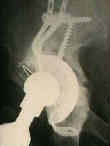
- Discussion:
- considerations:
- removal of press fit components can often be complicated by heavy bone ingrowth, insertion of under-reamed
components, or insertion of oversized peripherally oversized cups;
- acetabular exposure:
- w/ hybrid THR, typically the femoral stem is first removed (to improve exposure) but the cement is left in place (to reduce blood loss);
- if exposure is not optimal, then consider trochanteric osteotomy;
- entire circumference of the acetabular component must be visualized;
- polyethylene is then removed (may be performed w/ corkscrew or with insertion of 6.5 mm screw thru the polyethylene and against the metal cup);
- if screws are present, these are removed;
- references:
- A technique of revision of failed acetabular components leaving the femoral component in situ.
- polyethylene removal:
- polyethylene can be efficient removed by drilling into the polyethylene slightly off center (3.5 mm drill), and then by inserting a 6.5 mm screw in the polyethylene;
- as the screw is driven into the polyethylene the screw will hit the outer metalic shell, which then causes the polyethylene to be pulled away from the metal (until it disengages);
- be sure to insert the drill slightly off center inorder to avoid the central shell hole;
- screw removal:
- obviously all screws need to be removed before the acetabular shell is removed;
- note that acetabular screw heads will differ from company to company so be sure that the appropriately shaped screw driven is on the table before the case begins;
- cup removal:
- cautions: wedging out of the prosthesis before it is loose, may frx acetabulum or may removal a large piece of bone (along with the component);
- number one "rookie" mistake is to attempt to remove acetabular component prior to meticulous division of the metal-bone interface with curved osteotomes;
- osteotomes and gouges:
- using curved osteotomes and curve gouges help loosen the prosthesis with minimal bone damage;
- gouge is directed just external to the outer hemisphere of socket following curvature of the sphere;
- beaware of pegs and spikes in the acetabular component;
- always direct the cutting instrument slightly toward the prosthesis and away from the bone;
- grab one edge of the component w/ needle nose pliers and apply traction in order to allow a more advantageous position for gouge;
- as disruption of the bone metal interface proceeds, it will be necessary to use longer and longer gouges;
- the gouges are then cut in multiple directions;
- rod impactor agains the peripheral edge:
- apply a rod impactor (bone tamp) to the bottom edge of the metalic cup and attempt to drive (hammer) the inferior edge of the component toward the center of the acetabulum;
- this will help break up remaining osseous and fibrous attachments and will cause the superior component edge to become uncovered (which allows it to be extracted);
- rod impactor against the inner edge:
- stab incision is made over the postero-superior aspect of the ilium - at a point that will allow straight access to the posterosuperior aspect of the acetabulum;
- the abductor muscle is split, and a small drill and a drill sheath is inserted agains the posterosuperior edge of the acetabulum, at the "palpable flange" of the acetabulum;
- if a tungsten-carbide drill tip is used then the drill can be drilled through the acetabular shell inorder to
- a rod impactor is then introduced and is directed slightly anteriorly, and an attempt is made to impact the component out of the acetabulum;
- this technique is based on the observation that the anterosuperior aspect of the acetabulum is most important in
bearing weight during gait (posterosuperior region being less important);
- other methods:
- some components have a central threaded hole which allows insertion of a slap hammer;
- this method can result in component removal with a large segment of bone;
- occasionally the metal cup must be split into segments and removed in pieces;
- w/ a cemented prosthesis all acetabular cement must be removed, including cement plugs, which often remain firmly fixed to bone
A new technique for removal of the total hip arthroplasty acetabular component.
A new technique for removing non cemented acetabular components in revision total hip arthroplasty.
Removal of well-fixed, cementless, acetabular components in revision hip arthroplasty.


